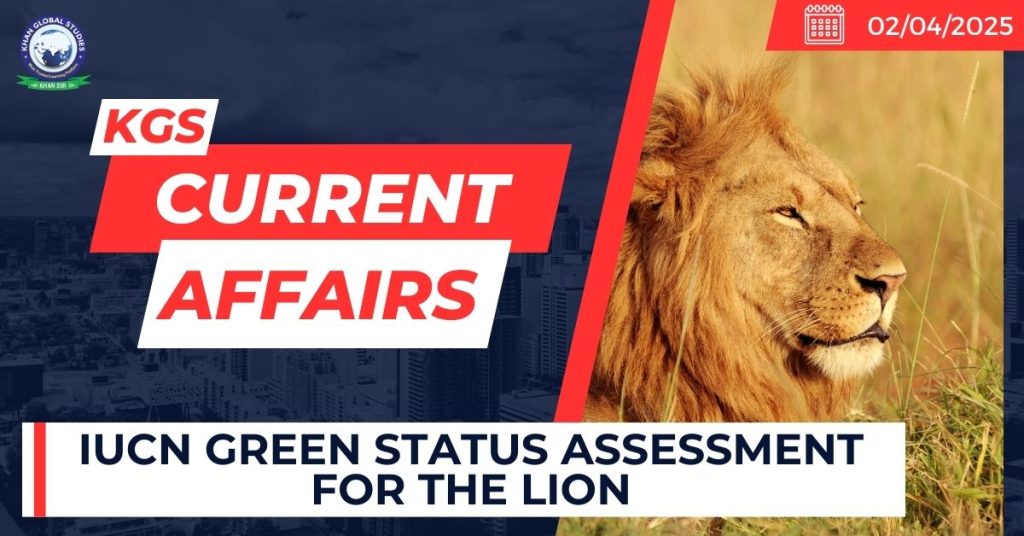Context:
Recently, the International Union for Conservation of Nature (IUCN) has released its first Green Status assessment for the lion (Panthera leo), classifying the species as “Largely Depleted.
Assessment Results
- The lion has been ranked as “Largely Depleted”, despite being listed as Vulnerable on the IUCN Red List.
- The Green Status assessment shows that human impacts are preventing the lion from being fully ecologically functional across its range.
- The species is declining across large areas and is extinct in North Africa and Southwest Asia.
- The assessment also reveals that conservation efforts have successfully prevented potential extinctions in West and Southern Central Africa, South Africa, and India.
- However, intensified conservation efforts are needed to sustain the existing population as human settlements continue to expand across the lion’s range.
Lion Subspecies Classification

The lion is the second-largest cat species in the world.
Lions described as two subspecies:
- The African Lion (Panthera leo leo) and
- The Asiatic Lion (Panthera leo persica).
Since 2017, a further sub-species has been recognized in East and Southern Africa, called the ‘southern lion’ (Panthera leo melanochaita).
Despite genetic differences, most African lions and Asiatic lions fall under the general Panthera leo category.
The IUCN Species Survival Commission (SSC) Cat Specialist Group currently divides lions into
1. Panthera leo leo (found in Central Africa, West Africa, and Asia).
2. Panthera leo melanochaita (found in Southern and East Africa).
Lion Population estimates:
- The African Lion population is estimated at around 23,000 adult and subadult lions across the continent.
- The Indian lion population is estimated at approximately 670 adult and subadult lions in Gujarat.
| Asiatic lion | African lion |
| · It was first described in 1826 by Johann Meyer, an Austrian zoologist.· The lion is closely related to West African and North African lions more than they are to Southern and East African lions.· Characteristics: Asiatic lions are slightly smaller than African lions.· Distinctive feature: A prominent longitudinal fold of skin running along the belly, which is unique to Asiatic lions and rarely seen in African lions.· Habitats: Today, they are only found in the Gir National Park and Wildlife Sanctuary in the southwestern Saurashtra region of Gujarat, which is a dry deciduous forest and open scrubland.· Status: Listed in Schedule I of Wildlife (Protection) Act 1972, in Appendix I of CITES and as Vulnerable on IUCN Red List. | · It is spread out across Africa, with the highest numbers concentrated around the East African region.· It was first described in 1758 by Carl Linnaeus in his book Systema Naturae.· The North and West African lions diverged from the East and Southern African lions about 180,000 years ago when the equatorial forest expanded and cut off the two regions.· Habitats: savannas, shrublands, and semi-arid deserts |
About the IUCN Green Status of Species
- The IUCN Red List of Threatened Species™ is the global standard for assessing the risk of extinction that individual species of animal, fungus, and plant face.
- However, there is also a need for an optimistic vision of species conservation, one that provides a road map for recovery.
- To achieve this, the Red List assessment process has been expanded to include new classifiers of species recovery and conservation impact, known as the Green Status of Species.
- The IUCN Green Status of Species complements the Red List by providing a tool for assessing the recovery of species’ populations and measuring their conservation success.
- In 2020, Green Status of Species assessments became an optional part of Red List assessments.
- The Green Status was first introduced by the IUCN in a paper published in Conservation Biology in July 2021.
The Green Status assessment is divided into nine recovery categories:
- Fully recovered
- Slightly depleted
- Moderately depleted
- Largely depleted
- Critically depleted
- Extinct in the wild
- Indeterminate
Current Status of Green Status Assessments: As of March 2025, there are over 100 IUCN Green Status of Species assessments on the IUCN Red List.

